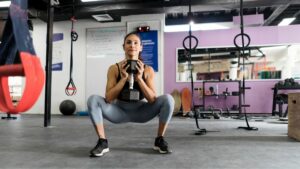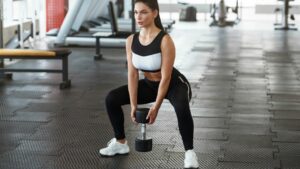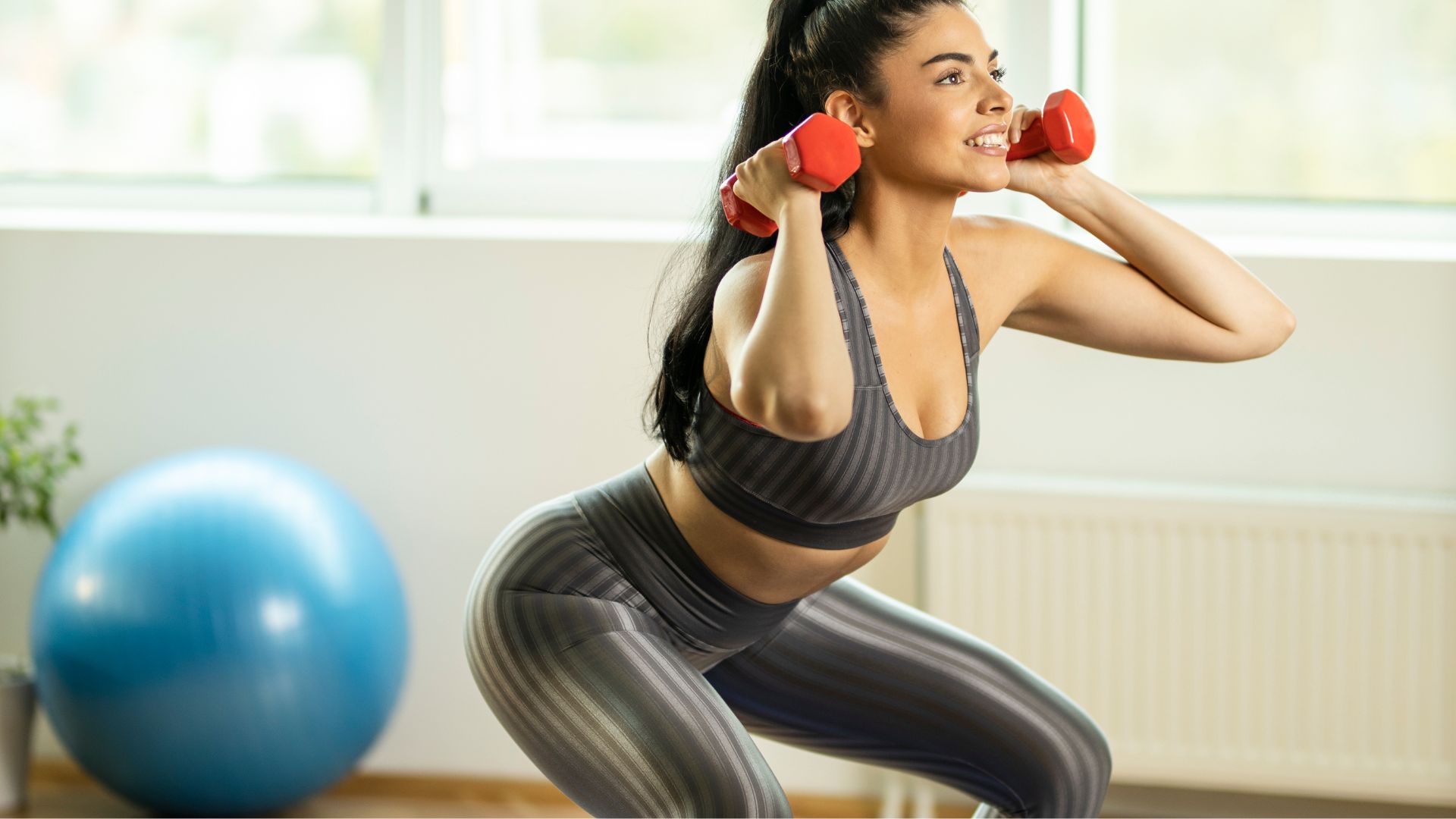Hey there, fitness enthusiasts! Ever wondered if knocking out 40 squats in a row with dumbbells is the secret sauce for those enviable glutes? Well, you’re in the right place!
In this blog post, we’re going to dive into the hot debate: Is doing 40 squats in a row with dumbbells actually bad for your glutes? We’ll uncover the facts, explore the nuances, and help you make informed decisions on your journey to sculpting those booty gains. So, let’s get ready to squat our way to the truth!
Understanding whether or not 40 squats in a row with dumbells are bad for the glutes.
Yes, if not done correctly, and No, if done the right way. Doing 40 squats in a row with dumbbells can be strenuous, and whether it’s “bad” for your glutes depends on various factors, including your fitness level, form, and individual body mechanics.
Here are some points to consider:
Form and Technique: The key to any exercise’s safety and effectiveness is proper form and technique.
If you maintain correct squat form throughout the set, you can minimize the risk of injury and maximize the benefits for your glutes.
Make sure your knees don’t go past your toes, your back stays straight, and your core is engaged.
Weight Selection: The dumbbell weight you choose also plays a significant role.
If the weight is too heavy, it can strain your lower back and possibly lead to poor squat form.
It’s important to select a weight that challenges you but allows you to maintain proper technique.
Fitness Level: Your current fitness level matters.
If you’re relatively new to squats or resistance training, doing 40 consecutive squats with dumbbells might be excessively challenging and could increase the risk of muscle fatigue and improper form.

Variation: Incorporating a variety of exercises into your routine can help prevent overuse injuries and ensure balanced muscle development.
Squats are effective for the glutes, but including other exercises that target the glutes from different angles can be beneficial.
Recovery: Adequate rest and recovery are crucial for muscle growth and injury prevention.
If you plan to do 40 squats in a row, ensure you allow your muscles to recover between sessions and incorporate rest days into your workout routine.
Consultation: It’s always a good idea to consult with a fitness professional or a physical therapist, especially if you have any existing injuries, concerns, or specific fitness goals.
They can provide personalized guidance based on your individual needs and circumstances.
In other words, doing 40 squats in a row with dumbbells can be beneficial for your glutes if done with proper form, appropriate weight, and consideration of your fitness level.
However, it’s important to be cautious and not overexert yourself, as this could potentially lead to strain or injury.
Balance your workout routine with a variety of exercises and consider seeking professional guidance if you have specific concerns.
Further Explanations.
Let’s dive deeper and elaborate further on all the points mentioned.
First, let’s delve deeper into the concepts of form technique and weight selection in the context of doing squats with dumbbells:
1. Form and Technique.
Knee Position:
Ensure that your knees do not extend beyond your toes during the squat. When your knees go too far forward, it can put excessive stress on the knee joint.
Instead, push your hips back and hinge at the hips while keeping your knees in line with your toes.
Back Alignment:
Maintain a straight and neutral back throughout the squat. Avoid rounding your lower back or arching it excessively, as this can lead to spinal issues.

Engage your core muscles to stabilize your spine.
Hip Hinge:
Squats are essentially a hip hinge movement. When you descend into the squat, imagine sitting back into a chair, and push your hips back as if reaching for that imaginary chair.
This helps engage the glutes and hamstrings effectively.
Depth:
Go as low as your flexibility allows without compromising form.
The goal is to reach at least parallel to the ground with your thighs, but you don’t need to go deeper unless you have the flexibility and mobility to do so safely.
2. Weight Selection.
Challenging, But Controllable:
The weight you choose should be challenging enough to stimulate muscle growth and strength gains but not so heavy that you sacrifice form.
You should be able to perform the entire set of 40 squats with proper technique.
Progressive Overload:
It’s common in resistance training to gradually increase the weight as you get stronger.
Start with a weight that allows you to complete the desired number of repetitions with good form, and over time, you can increase the weight incrementally to continue challenging your muscles.
Listen to Your Body:
If you’re struggling to maintain form or experiencing discomfort or pain during the squats, it’s a sign that the weight may be too heavy. Don’t hesitate to lower the weight to ensure safety.
In all this, maintaining proper form and technique during squats is crucial for preventing injury and maximizing the benefits for your glutes and other leg muscles.
It involves keeping your knees in the right position, maintaining a straight back, hinging at the hips, and controlling your depth.
When selecting a dumbbell weight, prioritize a weight that allows you to complete the exercise with good form, gradually increasing it as your strength improves. Always listen to your body and make adjustments as needed to ensure a safe and effective workout.
let’s explore the concepts of fitness level and exercise variation in more detail in the context of performing 40 consecutive squats with dumbbells:
3. Fitness Level.
Relative Experience:
If you’re new to squats or resistance training in general, attempting 40 consecutive squats with dumbbells may not be advisable.
Your muscles and joints need time to adapt to the demands of such an exercise. Starting with a lower number of reps and gradually increasing the intensity and volume over time is a safer approach.
Muscle Fatigue:
Doing a high volume of squats, especially with added weight, can lead to muscle fatigue, which can compromise your form and increase the risk of injury.
When muscles become fatigued, they may not provide the necessary support and stability for proper technique.
Progression:
It’s essential to progress gradually in your training.
Begin with a weight and rep range that aligns with your current fitness level and gradually increase the intensity and volume as your strength and endurance improve.
This progressive approach reduces the risk of overtraining and injury.
4. Variation:
Muscle Balance:
Focusing solely on one exercise, like squats, can lead to overuse injuries and muscle imbalances.
While squats are effective for the glutes, incorporating a variety of exercises that target the glutes from different angles can promote balanced muscle development.
For example, lunges, deadlifts, and hip thrusts are excellent additions to a lower body workout routine.
Functional Strength:
Different exercises can improve functional strength by challenging your muscles in diverse ways.
For instance, lunges emphasize single-leg stability, while deadlifts work on hip hinge mechanics. These variations can enhance overall lower body strength and stability.
Injury Prevention:
Engaging in a variety of exercises reduces the risk of overuse injuries.
When you repeatedly perform the same movement, such as squats, you may place excessive strain on certain muscles and joints. Introducing variety helps distribute the load more evenly.
In essense, your fitness level and exercise variety are essential considerations when planning a workout routine that includes squats with dumbbells:
- Tailor the intensity and volume of squats to your current fitness level to avoid overexertion.
- Gradually progress in weight and reps as your strength improves.
- Incorporate a variety of exercises to target the glutes and lower body muscles from different angles.
- Diverse exercises promote balanced muscle development, reduce the risk of overuse injuries, and enhance overall functional strength.

let’s elaborate on the importance of recovery and the value of consulting with fitness professionals or physical therapists:
5. Recovery.
Muscle Repair and Growth:
After a challenging workout like doing 40 squats in a row with dumbbells, your muscles experience microscopic damage.
Proper recovery allows your body to repair and rebuild these muscles, making them stronger and more resilient.
This is essential for muscle growth and overall progress in your fitness journey.
Injury Prevention:
Inadequate recovery can lead to overtraining, which increases the risk of injury.
Overworked muscles and joints are more susceptible to strains, sprains, and other overuse injuries. By allowing sufficient time for recovery, you reduce this risk.
Rest Days:
Incorporating rest days into your workout routine is crucial. These days give your muscles a chance to recover fully.
On rest days, you can engage in light activities like walking, yoga, or stretching to promote blood flow and muscle relaxation without placing additional strain on your body.
Sleep and Nutrition:
Recovery isn’t just about rest; it also involves getting enough quality sleep and proper nutrition.
Sleep is when your body performs most of its repair and growth processes. A balanced diet provides the necessary nutrients to support muscle recovery and overall health.
6. Consultation:
Professional Expertise:
Fitness professionals and physical therapists are trained to assess your individual needs and goals.
They can provide personalized advice and exercise programs tailored to your specific circumstances.
If you have any existing injuries, medical conditions, or concerns, they can help you choose exercises that are safe and effective for your situation.
Proper Form and Technique:
Professionals can teach you the correct form and technique for exercises like squats. This guidance is invaluable for preventing injuries and maximizing the effectiveness of your workouts.
Goal Setting:
Whether your goal is to build strength, improve mobility, or address specific health issues, consulting with a professional can help you set realistic and achievable goals. They can also track your progress and make adjustments to your training plan as needed.
Motivation and Accountability:
Working with a fitness professional can provide motivation and accountability. Knowing that you have scheduled sessions or regular check-ins with a trainer can help you stay committed to your fitness goals.
In summary, prioritizing recovery through rest, proper nutrition, and sleep is crucial for muscle growth and injury prevention. Rest days are essential, and they should be part of your workout routine.
Additionally, consulting with fitness professionals or physical therapists can offer you expert guidance, personalized training programs, and support in achieving your fitness objectives while minimizing the risk of injury.
A concise tabular on this topic here.
Here’s a concise tabular overview of the topic “Doing 40 Squats in a Row with Dumbbells and its Impact on the Glutes”:
| Aspect | Effect on Glutes |
|---|---|
| Form and Technique | Proper form minimizes the risk of glute injury |
| Correct form ensures glutes are engaged | |
| Weight Selection | Appropriate weight avoids straining lower back |
| Correct weight challenges glutes without compromising form | |
| Fitness Level | Newbies may find 40 squats too challenging, risking fatigue and improper form |
| Variation | Focusing solely on squats may lead to muscle imbalances |
| Including varied glute exercises prevents overuse injuries and promotes balance | |
| Recovery | Adequate rest and recovery support glute muscle growth and injury prevention |
| Consultation | Fitness professionals can offer personalized guidance for glute development |
| Consultation is especially valuable with existing injuries or specific fitness goals |
This table summarizes the impact of performing 40 squats in a row with dumbbells on your glutes, emphasizing the importance of form, weight selection, fitness level, exercise variation, recovery, and seeking professional guidance for the best results and safety.
Conclusion.
In conclusion, performing 40 squats in a row with dumbbells can have both positive and negative effects on the glutes.
It largely depends on factors like proper form, appropriate weight selection, individual fitness level, exercise variation, and prioritizing recovery.
To optimize glute development while minimizing the risk of injury, it’s crucial to strike a balance and consider consulting with fitness professionals for personalized guidance based on your unique circumstances and goals.

Hey there, it’s Mike Rrsq, the Editor-in-Chief over at Jsquat.com, and I’m absolutely obsessed with all things squat fitness! I’ve been lucky enough to get some serious recognition for my work in this field. With a solid background in the fitness and wellness industry, I’ve been there right from the get-go, helping shape this website into what it is today.
You see, I’m not just the boss around here; I’m also a passionate contributor. I love sharing my insights through my articles, and trust me, they’re not your run-of-the-mill stuff. Each piece I write is a labor of love, filled with my expertise and real-world experience in the fitness universe. So, if you’re into fitness and looking for some inspiration, you’re in the right place!

